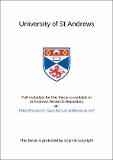Files in this item
Attention & response control : a neural and behavioural enquiry
Item metadata
| dc.contributor.advisor | Brown, Verity Joy | en |
| dc.contributor.author | Farovik, Anja | en |
| dc.coverage.spatial | vii, 142 p 30 cm. | en |
| dc.date.accessioned | 2021-04-08T08:57:26Z | |
| dc.date.available | 2021-04-08T08:57:26Z | |
| dc.date.issued | 2007 | |
| dc.identifier.uri | https://hdl.handle.net/10023/21885 | |
| dc.description.abstract | Goal directed responding is the behavioural expression of the myriad of cognitive processes which are involved in the translation of motivation to a motor program. These processes include learning, memory, expectation, anticipation, working memory and attention. The purpose of this thesis is to explore how and when attention exerts influence over responding and the neural basis of this. The introduction reviews the experimental literature on working memory and attention, noting that most work on attention stands quite separately from studies of working memory, although the contents of working memory may be regarded in some sense as the product of attentional selection. Chapter III describes work developing a new task of working memory. However, rats failed to learn the discrimination and so this line of investigation was not pursued further. In Chapter IV, a different approach was taken. The subthalamic nucleus (STN) is a key structure in the motor output pathways of the basal ganglia. However, a role for the STN in attentional selection, movement and switching has recently been raised. This chapter used a task of divided attention to examine the ability of rats with lesions of the STN to switch attention between modalities. However, an increased attentional load was not associated with an increase in the magnitude of lesion-induced performance deficits, suggesting that this nucleus is more likely involved in motor rather than attentional aspects of behaviour. Previous findings also suggest that an intact STN is important for response preparation in a task used to assess endogenous covert orienting of attention, while the attentional aspect of the task remained intact. Noradrenaline has been implicated in selective attention and in particular to play a role when stimuli are not fully predictable. Chapter V reports a study to investigate the role of noradrenaline in a test of covert spatial attentional orienting to endogenous cues. Depletions of the ascending noradrenergic system (DNAB) result in impairments supporting a role for this system in selective attention, however, there were no impairments in covert spatial attentional orienting. Previous work has suggested that the basal forebrain cholinergic system is important in covert orienting when the cues are exogenous. Therefore, Chapter VI examined the role of the basal forebrain cholinergic system in the test of covert orienting used in Chapter V, employing endogenous cues. Basal forebrain lesions impaired endogenous covert attentional orienting by abolishing the cost/benefit of the cue on reaction time to the visual target. Systemic injection of nicotine (a cholinergic agonist) did not re-establish directed attention in lesioned animals. This finding is the first to show the neural basis of endogenous covert orienting of attention, and suggest a common neural substrate for both exogenous and endogenous covert attention. Chapter VII considers the work of the thesis as a whole in the context of previous work and suggests directions for further research of this topic. | en |
| dc.language.iso | en | en |
| dc.publisher | University of St Andrews | en |
| dc.subject.lcc | QP405.F2 | |
| dc.subject.lcsh | Attention--Physiological aspects | en |
| dc.subject.lcsh | Movement, Psychology of | en |
| dc.title | Attention & response control : a neural and behavioural enquiry | en |
| dc.type | Thesis | en |
| dc.type.qualificationlevel | Doctoral | en |
| dc.type.qualificationname | PhD Doctor of Philosopy | en |
| dc.publisher.institution | The University of St Andrews | en |
This item appears in the following Collection(s)
Items in the St Andrews Research Repository are protected by copyright, with all rights reserved, unless otherwise indicated.

